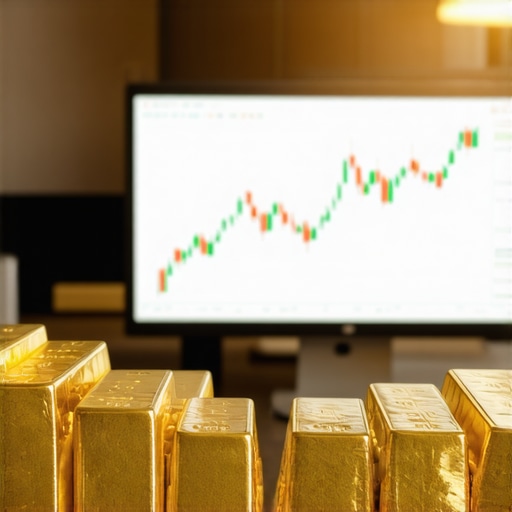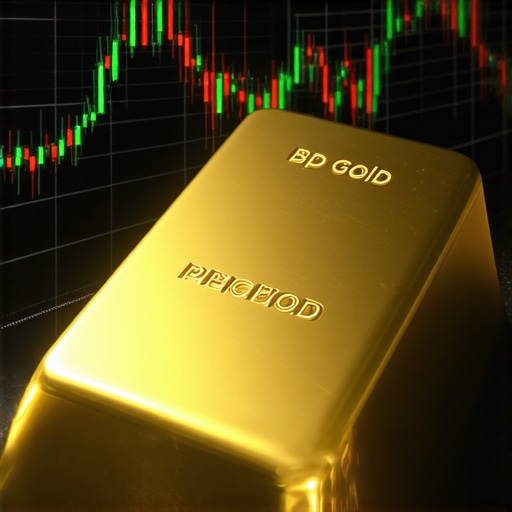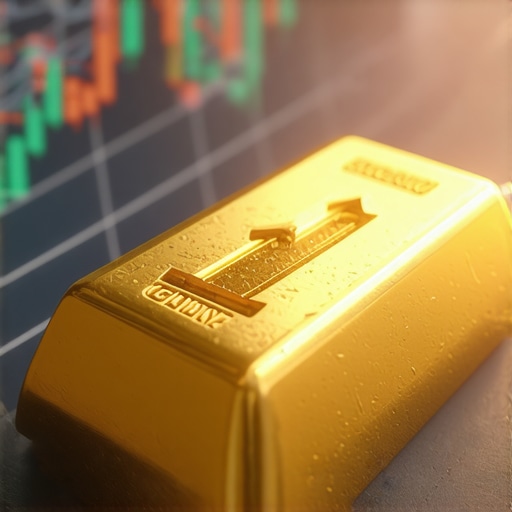Understanding the Gold Price Forecast: An Insightful Overview
The gold market is a critical component of the global financial landscape, influencing investment strategies and economic decisions worldwide. As investors seek to navigate the complexities of the gold market, understanding the gold price forecast becomes essential. This article will delve into both short-term and long-term predictions, providing insights into the factors that drive gold prices and what investors should consider.
Short-term Predictions: Navigating Market Volatility
In the short term, gold prices are often influenced by immediate market factors such as economic data releases, geopolitical tensions, and shifts in investor sentiment. For instance, announcements from central banks regarding interest rates can lead to fluctuations in gold prices. When interest rates are low, gold is generally seen as a more attractive investment compared to interest-bearing assets, leading to potential price increases.
Additionally, the demand for physical gold, particularly in markets like India and China, plays a significant role in short-term price movements. Seasonal demand, such as during festivals or wedding seasons, can create spikes in buying activity, driving prices upward. Investors should keep an eye on these trends to make informed decisions about their gold investments.
Long-term Predictions: The Bigger Picture
Looking at the long-term, the gold price forecast is shaped by broader economic factors, including inflation rates, currency strength, and global economic stability. Historically, gold has been viewed as a safe-haven asset during times of economic uncertainty. As inflation rises and currencies weaken, the appeal of gold often increases, leading to higher prices.
Analysts predict that as we approach 2025, factors such as growing global demand for gold, supply chain disruptions, and increased central bank purchases will influence the long-term gold price trajectory. For instance, many central banks have been accumulating gold reserves as a hedge against economic instability, which could lead to sustained demand and drive prices higher.
Moreover, technological advancements in gold mining and processing may also impact supply levels, thereby influencing prices. Innovations that increase efficiency in gold extraction can lead to a better supply balance, which is crucial for meeting increasing demand.
Conclusion: Strategic Insights for Investors
In conclusion, the gold price forecast is a multifaceted topic influenced by various short-term and long-term factors. Investors should remain vigilant, analyzing both market conditions and economic indicators to make informed investment decisions. For a more detailed analysis, you may explore our article on gold market analysis which discusses key players and their impact on prices. Understanding these dynamics will help you position yourself strategically in the gold market as we move forward.
Factors Influencing Gold Prices: A Detailed Examination
Understanding the intricacies of gold prices requires a comprehensive look at various influencing factors. These can range from geopolitical events to economic indices that shape the market. Investors must consider how these elements interact to forecast prices accurately.
Geopolitical Tensions: The Ripple Effect on Prices
Geopolitical tensions often lead to increased demand for gold as a safe-haven asset. For instance, during periods of war or political unrest, investors flock to gold to preserve value. This trend is particularly evident in regions experiencing instability, where gold prices may spike due to heightened demand.
Inflation and Currency Value: The Economic Indicators
Inflation is another critical factor influencing the gold price forecast. As inflation rises, the purchasing power of currency decreases, making gold more appealing. Investors often view gold as a hedge against inflation, driving up demand and, consequently, prices. Monitoring inflation rates and currency strength is essential for predicting future gold price movements.
Supply and Demand Dynamics: The Core of Pricing
The balance between supply and demand plays a vital role in determining gold prices. For instance, exploration and mining production levels can impact availability. If mining operations face challenges, such as regulatory hurdles or environmental issues, the supply may dwindle, leading to higher prices. Investors should keep track of reports regarding mining outputs and future production forecasts.
Investment Strategies for Navigating Gold Markets
As investors consider their positions in the gold market, developing effective strategies becomes paramount. Understanding various investment vehicles can help in achieving optimal returns.
Gold ETFs: A Popular Choice for Many Investors
Exchange-Traded Funds (ETFs) that focus on gold provide a way for investors to gain exposure without holding physical gold. These funds track the price of gold and are traded like stocks. Investors should explore options such as gold ETFs vs. mutual funds to determine the best fit for their portfolio.
Physical Gold Investments: Tangible Assets for Security
Investing in physical gold, such as coins or bars, offers a sense of security for many investors. Understanding the benefits of physical gold investments can help investors make informed decisions. While storage and insurance are considerations, the tangible nature of physical gold can provide peace of mind.
Long-term vs. Short-term Trading: Finding Your Approach
Deciding between long-term holding and short-term trading strategies is crucial. Long-term investors often benefit from market fluctuations, allowing them to ride out volatility. In contrast, short-term traders capitalize on immediate price changes, using techniques such as technical analysis to inform their decisions. For more insights on trading techniques, refer to our article on top gold trading techniques.
Conclusion: A Strategic Approach to Gold Investment
In conclusion, understanding the various factors that influence gold prices is vital for making informed investment decisions. By analyzing geopolitical events, economic indicators, and market dynamics, investors can develop effective strategies tailored to their risk tolerance and investment goals. For those looking to dive deeper into gold investments, our articles on essential tips for beginners and gold market analysis provide valuable insights to guide your investment journey.
Diversifying Your Gold Portfolio: Strategies for Success
Diversification is a critical strategy for investors looking to balance risk in their gold investments. By considering various types of gold-related assets, such as gold mining stocks, gold ETFs, and physical gold, investors can spread their risk and enhance potential returns. Each type of investment comes with its unique advantages and challenges, and understanding these can aid in developing a robust portfolio.
Gold Mining Stocks: Potential for High Returns
Investing in gold mining companies can offer significant upside potential. These stocks often correlate with the price of gold but can also be influenced by company performance and industry developments. For example, a company that discovers a new gold deposit can see its share price soar, providing investors with substantial profits. However, it’s essential to analyze the advantages of investing in gold mining stocks, including the inherent risks involved, such as fluctuating operational costs and regulatory challenges.
Gold ETFs: A Convenient Way to Invest
Gold ETFs remain a popular choice for many investors due to their liquidity and ease of trading. These funds allow investors to gain exposure to gold’s performance without the complexities of dealing with physical assets. By understanding the differences between gold ETFs and mutual funds, investors can make informed decisions about which option best suits their investment strategy.
Understanding Market Trends: The Key to Successful Investment
Staying informed about market trends is crucial for successful gold investing. This involves monitoring not only gold price movements but also analyzing broader economic indicators that affect gold demand.
Economic Indicators: What Investors Should Watch
Key economic indicators, such as inflation rates, interest rates, and employment statistics, can provide valuable insight into the future of gold prices. For instance, rising inflation typically drives investors towards gold as a hedge, increasing demand and pushing prices higher. Keeping an eye on global factors influencing gold demand trends can help investors anticipate market shifts and adjust their strategies accordingly.
Technical Analysis: Tools for Timing Your Investments
Utilizing technical analysis can enhance investment strategies by providing tools for predicting price movements. Techniques such as chart reading, trend analysis, and moving averages can help investors identify optimal entry and exit points in the gold market. Many successful traders incorporate these techniques into their decision-making processes. For more detailed methods, refer to our guide on advanced gold trading techniques.
Conclusion: Building a Comprehensive Gold Investment Strategy
In summary, navigating the gold investment landscape requires a multifaceted approach. By diversifying across various gold assets, staying informed about market trends, and utilizing effective trading strategies, investors can position themselves for success. For those eager to learn more about investing in gold, our resources on investing in gold for beginners and gold market analysis provide further guidance to enhance your investment journey.
Leveraging Economic Insights for Gold Investment
Understanding the economic landscape is vital for making informed gold investment decisions. The interplay between various economic factors influences not just gold prices but also investment strategies tailored for long-term success. Investors should pay attention to central bank policies, geopolitical stability, and overall market sentiment, as these can significantly impact demand for gold.
The Role of Central Banks in Gold Prices
Central banks are major players in the gold market, often holding substantial amounts of gold as part of their reserves. When central banks decide to buy or sell gold, it can lead to significant price fluctuations. For instance, increased gold purchases by central banks can signal growing uncertainty in the economy, prompting investors to seek the safety of gold. To understand this dynamic better, explore our article on central bank gold purchases and their market impacts.
Geopolitical Factors: Navigating Market Volatility
Geopolitical tensions can create uncertainty, leading to increased demand for gold as a safe-haven asset. Events such as conflicts, elections, and trade negotiations can drive investors to gold, pushing prices higher. By keeping abreast of current events and their potential implications on the gold market, investors can better position their portfolios to capitalize on these shifts. For instance, understanding how global factors influence gold demand trends can enhance your investment strategy.
Risk Management: Essential for Gold Investors
Every investment carries risks, including gold. Implementing effective risk management strategies is crucial for protecting your investment. This involves not only diversifying your portfolio but also employing stop-loss orders and position sizing to mitigate potential losses.
Implementing Stop-Loss Orders
Stop-loss orders are a fundamental tool for managing risk in your gold investments. By setting a predetermined price at which your investment will automatically sell, you can limit your losses in a declining market. This strategy is particularly useful in the highly volatile gold market, where prices can swing dramatically based on external factors.
Position Sizing: Balancing Your Portfolio
Position sizing refers to determining how much of your capital to allocate to each investment. In gold investing, it’s important to balance your exposure relative to your overall portfolio size and risk tolerance. By adhering to sound position sizing practices, investors can ensure they are not overly exposed to any single investment, maintaining a healthier portfolio balance.
Future Considerations: Staying Ahead of Gold Investment Trends
As the gold market evolves, staying informed about future trends and innovations is essential. The rise of digital gold and blockchain technology is reshaping how investors engage with gold assets, offering new opportunities for diversification and investment.
Exploring Digital Gold Options
Digital gold platforms allow investors to buy, sell, and store gold in digital form, making transactions more convenient and accessible. As these platforms gain popularity, they are likely to change the investment landscape significantly. Investors should stay updated on the latest developments in this space to leverage potential advantages.
Innovations in Gold Investment Strategies
Emerging technologies and methodologies are continually reshaping gold investment strategies. For example, advancements in data analysis and artificial intelligence are being utilized to predict market trends and optimize trading strategies. Investors who are open to adopting these innovations may find themselves at a competitive advantage. For more insights on effective techniques, visit our post on proven gold trading techniques for profitable investments.
Frequently Asked Questions About Gold Investment
What factors influence gold prices?
Gold prices are predominantly influenced by market demand and supply, central bank policies, geopolitical stability, and economic indicators. Investors should monitor these factors closely to make informed investment decisions.
Is gold a good investment during economic downturns?
Yes, gold is often considered a safe-haven asset during economic downturns. Its value tends to hold up better than other investments when market volatility increases, making it a smart choice for risk-averse investors.
How can I start investing in gold?
Investing in gold can be done through various methods, including purchasing physical gold (like coins and bars), investing in gold ETFs (exchange-traded funds), or using digital gold platforms. Each option has its unique advantages and considerations.
What is the best way to store physical gold?
Physical gold should be stored securely, preferably in a safe deposit box at a bank or a secure home safe. Proper storage minimizes the risk of theft or loss and ensures the asset remains in good condition.
How does inflation affect gold prices?
Inflation typically leads to higher gold prices as investors seek to hedge against the loss of purchasing power. When inflation rises, the demand for gold often increases, driving up its price.
Are gold investment funds a better option than physical gold?
Gold investment funds, such as ETFs, offer liquidity and ease of trading compared to physical gold. However, they may not provide the same level of security as holding physical assets. The choice depends on individual investment goals and preferences.
What is the correlation between gold and the US dollar?
Gold generally has an inverse relationship with the US dollar. When the dollar weakens, gold prices tend to rise as it becomes cheaper for foreign buyers. Conversely, a strong dollar often leads to lower gold prices.
How do geopolitical events affect gold investments?
Geopolitical events, such as wars, elections, and trade disputes, can create uncertainty in the markets, prompting investors to turn to gold as a safe-haven asset. This increased demand can drive up gold prices significantly.
What are the tax implications of investing in gold?
In many jurisdictions, gold investments are subject to capital gains tax. It’s essential to consult a tax professional to understand the specific tax obligations related to buying and selling gold.
Authority Resources for Gold Investment
Investors looking to deepen their understanding of gold investments should refer to reputable sources. Here are some trusted websites and literature:
- Investing.com – Offers market analysis and insights on various asset classes, including gold.
- World Gold Council – A leading authority on gold investment, providing data, research, and insights into the gold market.
- BullionVault – A platform for buying, selling, and storing physical gold, with comprehensive guides and resources for investors.
- Kitco – A well-respected source for gold market news, analysis, and live price updates.
- Forbes – Offers articles and insights on investment strategies, including gold and precious metals.
Conclusion
Investing in gold is a multifaceted endeavor that requires understanding economic indicators, risk management, and emerging trends. By leveraging insights from central bank activities, geopolitical factors, and innovative technologies, investors can position themselves for success in the gold market. Whether you’re considering physical gold, ETFs, or digital gold options, the key is to stay informed and adaptable. Utilize the resources and strategies discussed to navigate this lucrative but complex investment landscape. Embrace the opportunities that gold investment presents, and you may find it to be a valuable addition to your portfolio.











I’ve been watching the gold market closely, and I find your insights about short-term and long-term predictions really comprehensive. It’s fascinating how geopolitical tensions and inflation can dramatically drive up gold prices. I remember during the last economic downturn; my portfolio suffered, but my investments in gold managed to hold their value. I think many investors underestimate the importance of timing and understanding the underlying factors that affect gold prices. The point about seasonal demand in countries like India really struck me; it’s a clear example of how cultural aspects can impact market movements. Rather than quick trades, I’ve considered establishing a more stable investment in gold ETFs while keeping some physical gold for security. As I look towards 2025, I wonder how technological advancements you mentioned might influence both supply and investment strategies. It seems like the gold landscape is evolving rapidly, and it’s critical for investors to stay informed and nimble. Thanks for shedding light on these dynamics, they will surely shape my approach moving forward!
Your comprehensive overview of gold price forecasting really resonates with my experience. I’ve found that short-term volatility often catches less experienced investors off-guard, especially with geopolitical tensions spiking suddenly, which does create excellent entry points if one is prepared. Personally, I’ve been diversifying my holdings between physical gold and ETFs, aiming for flexibility—physical gold for security and ETFs for liquidity. Your point about technological advancements in mining caught my attention; innovations like blockchain for tracking gold provenance are promising for transparency and could very well stabilize supply chains in the future. I’m curious, do you think the rise of digital gold platforms will significantly alter traditional gold investing, or are they more of a complementary tool? Also, with central banks increasing their gold reserves, do you foresee a sustained upward trend in prices, or might there be a correction if global economic stability improves? It’s an exciting time for gold investors, and staying informed about these evolving trends is key. Thanks for sharing such a detailed analysis—definitely gives me some ideas to refine my strategy.